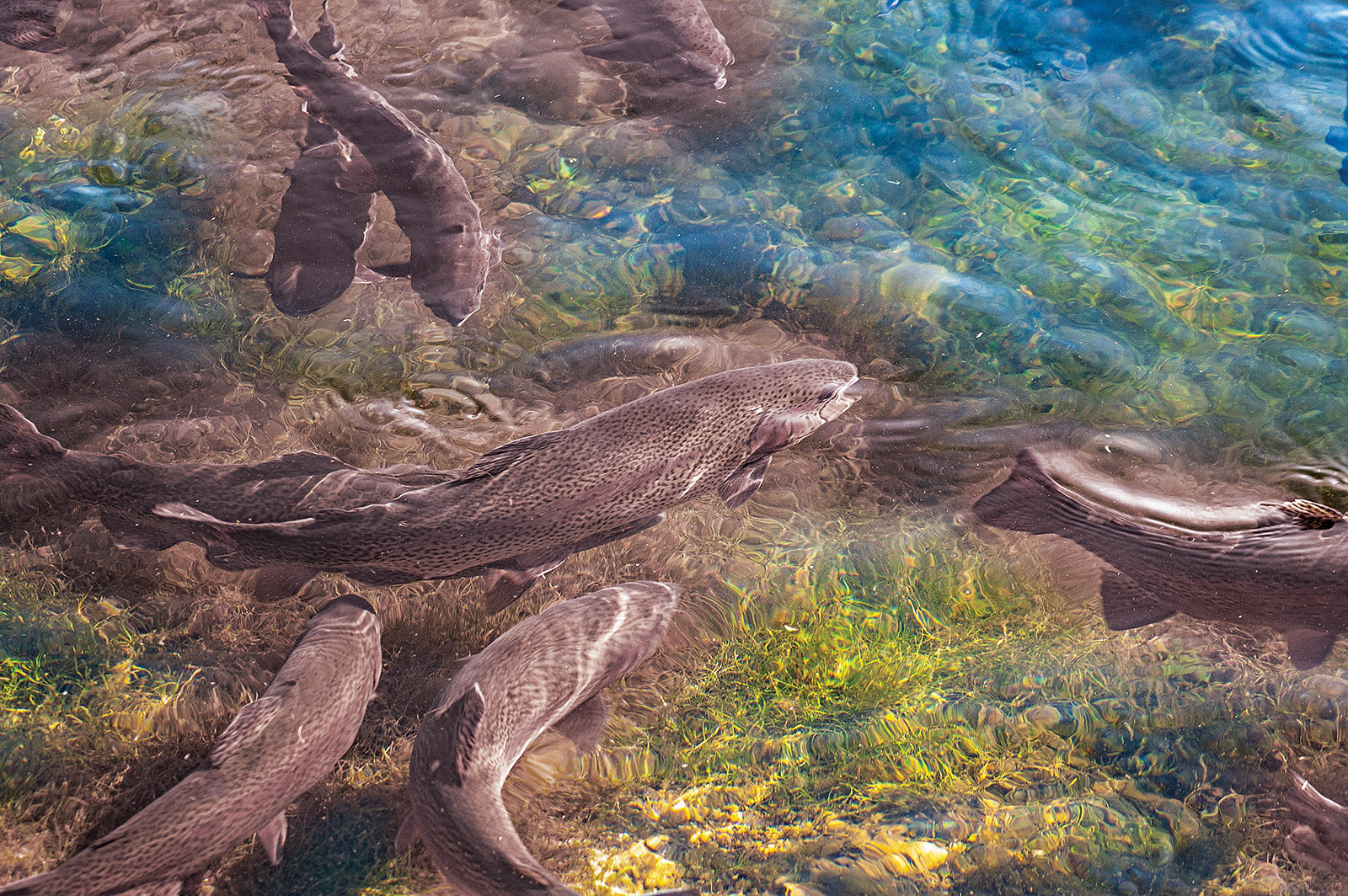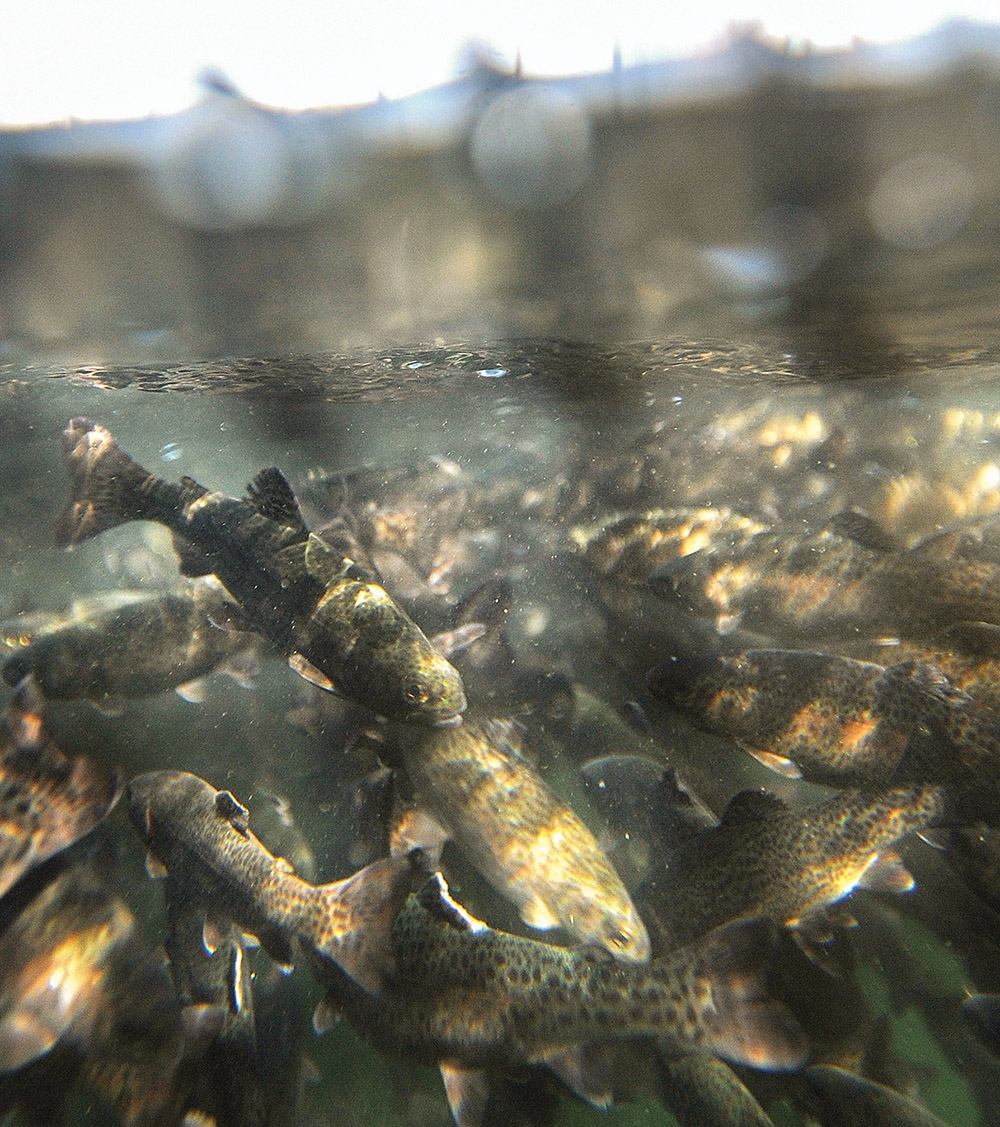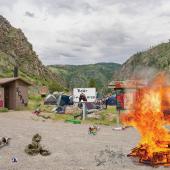Troutopia
Natives, invasives, and coexistence in Montana waters.
Nothing is more fulfilling than returning to Montana after an extended period of time. Except this: returning to find an old fishing hole exactly as you left it. No alteration from spring runoff, no shirtless dudes in cutoff jeans plying it with nightcrawlers. Just that beloved stretch of water that produced so many good days in the past, and so many more to come.
This was my state of mind one beautiful summer day as I arrived back in Bozeman after a stint in Colorado. Happy to have busy freeways and tiny trout behind me, I pulled up to my favorite spot to find another vehicle parked in the middle of the road, sporting California plates. The invasive-Californian mythos surrounding my upbringing struck deep chords. Who was this out-of-state jerk that had beaten me to myfishing spot? I fumed over sips of coffee before rigging up.
As I approached the river through willows and cottonwoods, I saw the migrant standing right in the very hole I spent all week dreaming about. I sulked momentarily before plodding upstream where the water was swift and lacking cover. A hundred yards away from the foreigner, rancor quickly morphed to elation as a fish popped my Purple Haze, turning my day around. When I netted the rainbow, I looked downstream and saw my Beverly-Hilled bidder watching me, with what appeared to be a combination of amazement and jealousy. As I stood on the bank, proudly admiring my hefty trout, the irony of the situation went completely over my head.

The Rainbow Foray
When the Corps of Discovery made it past the Great Falls in the summer of 1805, aquatic life in what would become Montana was as intact and “natural” as it had been since the retreat of polar ice sheets near the end of the last ice age. It was 1889 when Montana officially achieved statehood—the same year the first rainbow trout arrived in Montana streams, transplanted from the McCloud River drainage in northern California. Before this invasive fish arrived, whitefish, grayling, suckers, burbot, lake trout, and cutthroat trout—both Yellowstone and westslope—were seven of the 17 endemic species dwelling in Montana waterways upstream of the Great Falls. If there were any native rainbows in the state, they would have been in the Kootenai River in far northwest Montana.
The idea of a large-scale operation transporting species of fish to different watersheds gained traction following the conclusion of the Civil War. After five long years of tumultuous conflict, the U.S. government chose fishing as a way to bridge camaraderie and traditionalism amongst a divided population of American men. Newborn fishing exhibits helped popularize the wily nature of the rainbow trout. This fish quickly became the primary target among anglers for its eagerness to take a fly, its reputation of being a staunch fighter, and its tendency to leap multiple times out of the water. Most exciting was its ability to adapt to a range of freshwater environments—offering every angler, from the proletarian to the elite, a quarry for both sustenance and recreation.
The stocking of Montana rivers began in the end of the 19th century. In the decades that followed, the suite of introduced fish expanded to include rainbow trout, brown trout, brook trout, kokanee salmon, warmwater fish, and even steelhead. Much of this was designed as a method to bring in tourist dollars, ensuring fish were easily catchable by fisherman of all skill levels. Stocking continued casually until1974, when studies showed that hatchery fish were harmful to wild trout. The discovery was polarizing for public and state officials, and a hotly contested debate over economic benefits and ecological preservation ensued.
Eventually, the state came around when some of the fly-fishing industry’s biggest icons—Bud Lilly, Dan Bailey, Charlie Brooks, and Cal Dunbar—joined the fray, acknowledging that the quality of fishing had been steadily declining. This stance was bolstered by the findings of Dick Vincent, a wildlife biologist who showed that fish were decreasing in number and size on the Madison River. These folks soon became avant-garde leaders of the fly-fishing community, and proved pivotal for establishing a constituency of public support for wild-trout preservation.
A Natural New Home
Montana has been ecologically and culturally shaped by the influence of invasive rainbow and brown trout. Their introduction and ability to thrive in many different aquatic landscapes without human intervention has led to a common misperception that these wild fish are native. But like the frothy rivers of late spring, designations get murky. Native fish are “wild” fish—they made their home in Montana waters through the biogeographic displacement of the ice age. Invasive fish can also achieve “wild” status if they are able to reproduce in the environment they’re introduced in. In the case of Montana, many stocked fish—ones that were born and raised in hatcheries—survived long enough after introduction that they were able to reproduce and effectively create the “wild” strains we catch today. Thus, the majority of fish in Montana are wild, yet most of them are descendants of stocked and introduced parents.

Although as “wild” as their native brethren, these non-native fish have dramatically altered the historic habitat and uniqueness of native species. Introduced rainbow trout rapidly bred with their distant relatives, the cutthroat trout, resulting in the hybrid subspecies commonly referred to as the cutbow trout. The cutbow, with its superior ability to withstand abnormal ecological conditions (such as whirling disease), promptly spread to all major drainages it had access to. These genetically modified organisms have infiltrated many western streams, resulting in homogenized trout instead of the unique, biogeographically diverse fish that originally inhabited the streams of the Rocky Mountain region. This hybridization conjures up many biological and ethical problems, ranging from a loss of diversity to considerations about when a species qualifies for protection under the Endangered Species Act.
The encroachment of rainbow trout on native species extends beyond the waters of Montana—and beyond the activity of fishing. Consider that rainbow trout were originally found only in streams west of the Rocky Mountains, all the way up into Alaska and the Kamchatka Peninsula. They now dwell in 87 countries worldwide—from New Zealand to South Africa, to Costa Rica and the Himalayas. Their globalized reach has resulted in many ecological dilemmas; most notably hegemony, or a reduction of rich diversity as a result of an array of characteristics being condensed into a single, standardized pattern. The loss of diversity drives out the natives, causes biological dislocation, and in some cases, changes the economic and political landscape of entire communities. This process parallels the economic process of globalization, wherein people, nations, and ecosystems have significantly altered unique environments and social systems worldwide, a resemblance that may be affecting our sentiments on invasive fish.
As It Stands
Today, many of the sociocultural standpoints and misperceptions that enable invasive fish to thrive were structured long before our arrival. Rainbow and brown trout did not become the most popular angling quarry because of their geographic placement; they became popular because they outcompeted all other fish. Very similar to competing species of trout, cultural value judgements based on beliefs often shape people’s perceptions and ethical stances. With their lauded popularity and symbolic denotation in the angling community, trout have been elevated to sacrosanct status. Most conscientious fishermen avoid killing these seemingly fragile organisms while pursuing their favorite sport. Not wanting to see fish die is one of the many reasons why removing invasives has become such a controversial topic in Montana. Nonetheless, certain camps have surmised that the protection of native species supersedes affection for fish as an entity, to the effect of killing off non-native populations and restoring native ones, the most renowned—and controversial—example being Cherry Creek, a tributary of the lower Madison that was poisoned and restored with native cutthroat trout in 2010.
Despite ongoing efforts to suppress non-native fish, the reality is that rainbow trout, brown trout, and other introduced species are here to stay. Even if it were theoretically possible to restore fisheries to the condition the Corps of Discovery found them in at the beginning of the 19th century, it is now culturally and politically impossible, and physically impractical. On that day of return to my favorite fishing hole, the presence of two non-natives—me and the Californian—distilled in my mind the understanding that Montana streams are dictated by human preferences. We all have to learn to coexist, and acknowledge the impacts of our influence on nature. When we find our presumptions and attitudes defiling heritage, we must recognize the consequences of our artificially populated waterways and understand the importance of our true native species—both fish and human. Our generation did not deliberately construct the problems we face with invasive fish; we just inherited them. There are no end-all solutions to the native-versus-invasiveissue, only continual corrections, ongoing education, and—if we’re lucky—increased understanding of the complexity and significance of the problems at hand.













